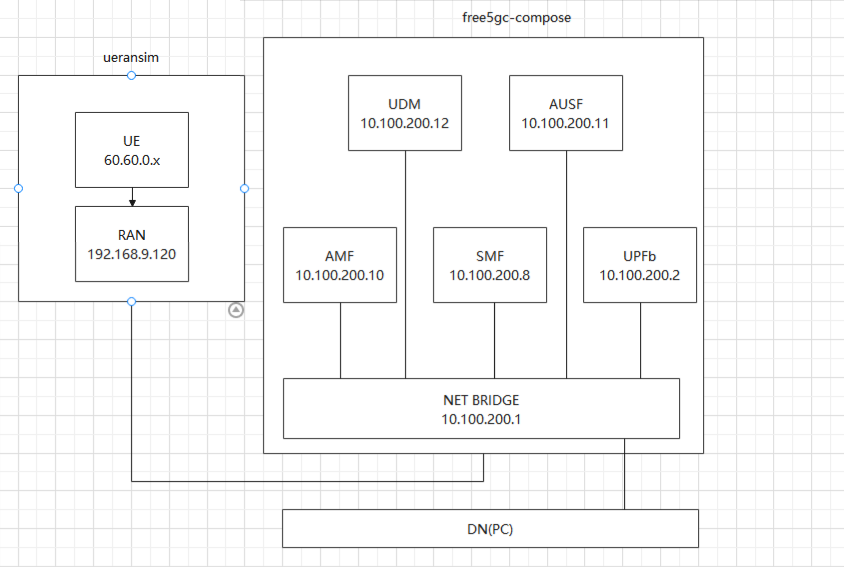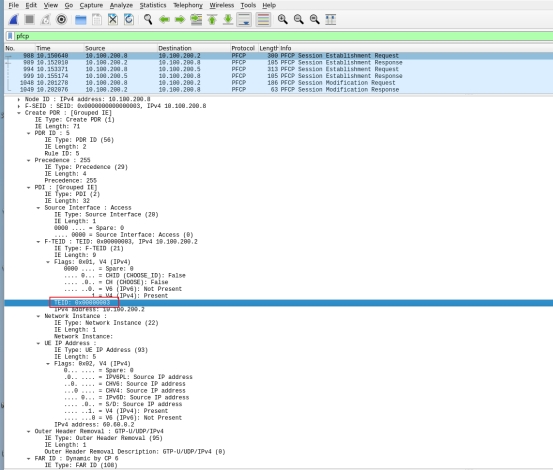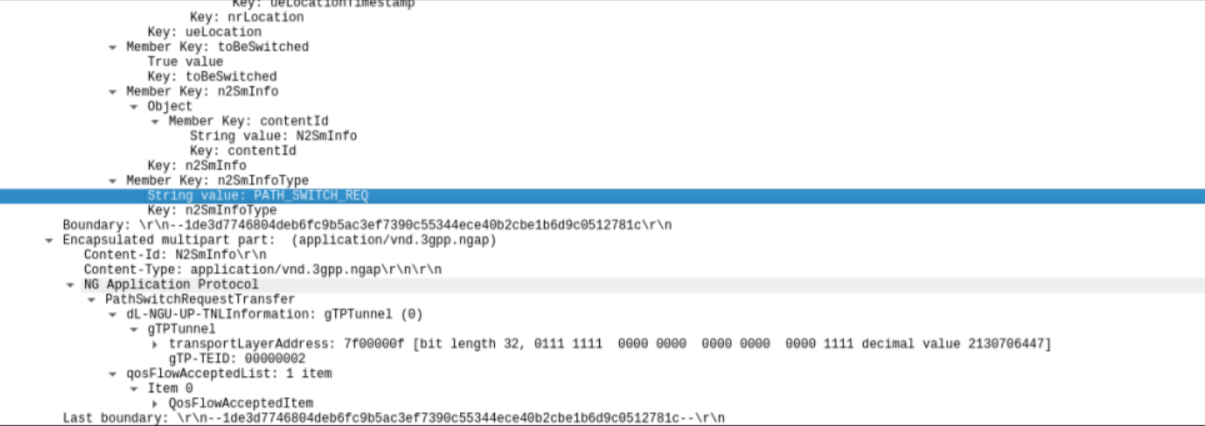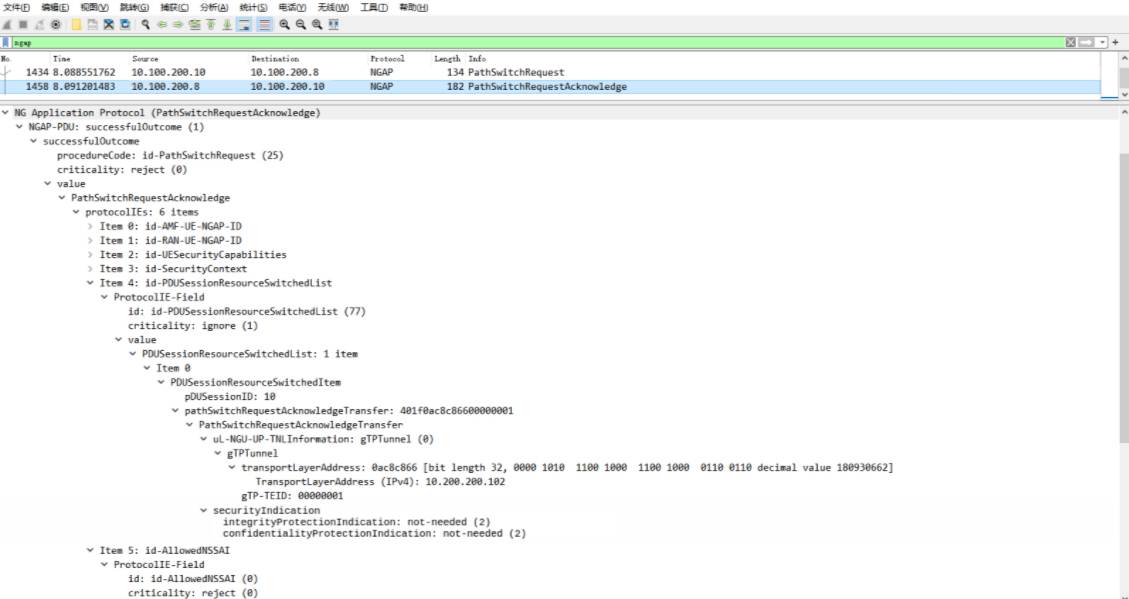基于free5gc+UERANSIM的5G SMF及UPF 网元安全需求分析
时间:2021-12-28
前言
随着国内5G网络的快速建设,5G的安全问题受到越来越多的关注。本文在《free5gc+UERANSIM模拟5G网络环境搭建及基本使用》的模拟环境基础上,对《3GPP安全保障规范(SCAS)》(SeCurity Assurance Specifications,简称SCAS)的系列文档《3GPP TS 33.513》以及《3GPP TS 33.515》中定义的SMF(Session Management Function)和UPF(User Plane Function)网元安全需求进行了报文和代码分析,旨在为5G安全研究及测试人员提供参考。
一、概念介绍
3GPP在《3GPP安全保障规范(SCAS)》规范中为网元定义了安全需求和测试用例,《3GPP TS 33.513》和《3GPP TS 33.515》属于《3GPP安全保障规范SCAS》规范文档。两者分别规定了UPF和SMF特有的安全需求,这些特定安全要求既包括相关规范中针对UPF和SMF的安全功能要求,也包括与安全要求相关的测试用例。
1.1 网元介绍
UPF(User Plane Function)网元
负责分组路由转发,策略实施,流量报告,Qos处理等。
SMF(Session Management Function)网元
负责处理用户的业务,可以看成是 MME 承载管理部分以及 SGW 和 PGW 的控制面功能的组合。
1.2 安全需求对应流程
文中分析的三条安全需求对应PDU会话流程中具体步骤如下:
TEID的唯一性
数据面隧道端点标识符(TEID)是由UDF分配且是不可重复的,SMF通过CreatePDR向UPF申请某个接口的TEID,对应PDU会话流程中的N4会话请求N4SessionEstablishmentRequest和响应报文N4SessionEstablishmentResponse。
UP安全策略的优先级
触发PDU会话建立流程,SMF通过Nudm_SDM_Get服务从UDM检索会话管理订阅数据,SMF发送的N1N2消息中包含了 UDM的用户面安全策略,对应PDU会话流程中的Namf_Communication_N1N2MessageTransfer。
SMF检查UP安全策略的安全功能要求
NG-RAN 节点通过向 AMF 发送 PATH SWITCH REQUEST 消息来启动该过程。SMF验证Path-Switch message中UE的5G安全能力,是否与SMF自身存储的相同,若不相同,SMF应将其本地存储的UE的对应PDU会话的UP安全策略发送到目标gNB,对应PDU会话流程中的Nsmf_PDUSession_SMContextUpdate Response。
二、 模拟环境介绍
本节简单介绍了UERANSIM+free5gc环境,用户可以通过使用arp、ifconfig、docker inspect及网桥brctl相关命令,来收集容器IP及mac地址等相关信息,绘制的组网示意图如下:

如上图所示:环境基于ubuntu 20.04 VMware虚机部署,5gc网元分别部署在虚机的docker容器中。5gc各模拟网元与模拟RAN通过虚拟网桥进行数据交换。物理机上的VMware虚拟网卡作为DN(互联网节点)通过虚拟网桥与容器中的UPF对接。详细的搭建方法可以参考沉烽网络安全实验室的文章《free5gc+UERANSIM模拟5G网络环境搭建及基本使用》。
三 、安全需求条目分析
3.1 UPF安全需求分析
3.1.1 TEID的唯一性
需求描述
当建立或者发布一个新的PDU会话时,将执行CN隧道信息的分配和释放,此功能基于运营商在SMF上的配置,并由SMF或UPF网元支持。如《3GPP TS 23.501》第5.8.2.3.1条所述,CN隧道信息是与PDU会话相对应的N3/N9隧道的核心网络地址。它包括由UPF在N3/N9隧道上使用的用于PDU会话的TEID和IP地址,CN隧道信息的分配和发布将由UPF执行。当UPF需要分配/发布CN隧道信息时,SMF应向UPF发出指示。
隧道端点标识符(TEID):此字段在接受GTP U协议实体中明确标识隧道端点。GTP隧道的接收端本地分配发送端必须使用的TEID值。
TEID是一个逻辑节点的一个IP地址内的唯一标识符。
输入条件
1.测试者截获测试UPF和SMF之间的流量。
2.测试者触发最大并发N4会话建立请求次数。
3.测试者捕获从UPF向SMF发送的N4会话建立响应,并验证为每个生成的响应创建的F-TEID是唯一的。
输出结果
每个不同的N4会话建立响应中设置的F-TEID是唯一的。
条目分析
捕获到SMF向UPF网元发送的PFCPSessionEstablishmentRequest请求。

参照\smf\producer\pdu_session.go中的HandlePDUSessionSMContextCreate函数,其中调用了SendPFCPRules函数,定位到\smf\producer\datapath.go中的SendPFCPRules函数,在此函数中进行PfcpSessionEstablishmentRequest报文的发送。
for ip, pfcp := range pfcpPool {
sessionContext, exist := smContext.PFCPContext[ip]
if !exist || sessionContext.RemoteSEID == 0 {
pfcp_message.SendPfcpSessionEstablishmentRequest(
pfcp.nodeID, smContext, pfcp.pdrList, pfcp.farList, nil, pfcp.qerList)
} else {
pfcp_message.SendPfcpSessionModificationRequest(
pfcp.nodeID, smContext, pfcp.pdrList, pfcp.farList, nil, pfcp.qerList)
}
}在发送PfcpSessionEstablishmentRequest报文之前,传入接口的SMContext中已经生成了GTP Tunnel信息,定位到\smf\producer\pdu_session.go的HandlePDUSessionSMContextCreate函数。
if smf_context.SMF_Self().ULCLSupport curDataPathNode != nil; curDataPathNode = curDataPathNode.Next() {
logger.PduSessLog.Traceln("Current DP Node IP: ", curDataPathNode.UPF.NodeID.ResolveNodeIdToIp().String())
if err := curDataPathNode.ActivateUpLinkTunnel(smContext); err != nil {
logger.CtxLog.Warnln(err)
return
}
if err := curDataPathNode.ActivateDownLinkTunnel(smContext); err != nil {
logger.CtxLog.Warnln(err)
return
}
}然后进入到\smf\context\datapath.go中的 ActivateUpLinkTunnel函数, teid是在此处由UPF生成的。
func (node *DataPathNode) ActivateUpLinkTunnel(smContext *SMContext) error {
var err error
logger.CtxLog.Traceln("In ActivateUpLinkTunnel")
node.UpLinkTunnel.SrcEndPoint = node.Prev()
node.UpLinkTunnel.DestEndPoint = node
destUPF := node.UPF
if node.UpLinkTunnel.PDR, err = destUPF.AddPDR(); err != nil {
logger.CtxLog.Errorln("In ActivateUpLinkTunnel UPF IP: ", node.UPF.NodeID.ResolveNodeIdToIp().String())
logger.CtxLog.Errorln("Allocate PDR Error: ", err)
return fmt.Errorf("Add PDR failed: %s", err)
}
if err = smContext.PutPDRtoPFCPSession(destUPF.NodeID, node.UpLinkTunnel.PDR); err != nil {
logger.CtxLog.Errorln("Put PDR Error: ", err)
return err
}
if teid, err := destUPF.GenerateTEID(); err != nil {
logger.CtxLog.Errorf("Generate uplink TEID fail: %s", err)
return err
} else {
node.UpLinkTunnel.TEID = teid
}TEID的唯一性生成逻辑见smf\context\upf.go中的GenerateTEID函数及idgenerator\id_generator.go中的NewGenerator函数和Allocate函数。
func (upf *UPF) GenerateTEID() (uint32, error) {
if upf.UPFStatus != AssociatedSetUpSuccess {
err := fmt.Errorf("this upf not associate with smf")
return 0, err
}
var id uint32
if tmpID, err := upf.teidGenerator.Allocate(); err != nil {
return 0, err
} else {
id = uint32(tmpID)
}
return id, nil
}
//free5gc/idgenerator/id_generator.go
func (idGenerator *IDGenerator) Allocate() (id int64, err error) {
idGenerator.lock.Lock()
defer idGenerator.lock.Unlock()
offsetBegin := idGenerator.offset
for {
if _, ok := idGenerator.usedMap[idGenerator.offset]; ok {
idGenerator.updateOffset()
if idGenerator.offset == offsetBegin {
err = errors.New("No available value range to allocate id")
return
}
} else {
break
}
}
idGenerator.usedMap[idGenerator.offset] = true
id = idGenerator.offset + idGenerator.minValue
idGenerator.updateOffset()
return
}
func (idGenerator *IDGenerator) updateOffset() {
idGenerator.offset++
idGenerator.offset = idGenerator.offset % idGenerator.valueRange
}
3.2 SMF安全需求分析
3.2.1 SMF检查UP安全策略的安全功能要求
需求描述
SMF应验证从目标NG-eNB/gNB接收的UE的UP安全策略与SMF本地存储的UE的UP安全策略相同。如果不匹配,SMF应将其本地存储的UE的对应PDU会话的UP安全策略发送到目标gNB。如果SMF包括该UP安全策略信息,则该UP安全策略信息被传递到路径切换消息中的目标NG-eNB/gNB。SMF应记录此事件的能力,并可采取其他措施,例如发出警报。
威胁参考:如《3GPP TR 33.926》第J.2.2.4条所述,SMF需要验证从NG-eNB/gNB接收的UP安全策略是否与存储在SMF本地的相同。如果SMF未能检查,上行通信的安全性可能会降低。例如,如果从NG-eNB/gNB接收的UP安全策略指示没有安全保护,而本地策略要求相反的安全保护,并且SMF在没有验证的情况下使用接收的UP安全策略,则用户平面数据将不受保护。
输入条件
1.测试者向被测SMF发送Nsmf_PDUSession_SMContextUpdate Request消息。请求消息中包含的UE UP安全策略与在被测SMF上预先配置的策略不同。
2.测试者捕获SMF发送的Nsmf_PDUSession_SMContextUpdate Response消息。
输出结果
预先配置的UE安全策略包含在捕获的响应消息中的“n2SmInfo”IE中。
HandlePathSwitchRequestTransfer会对ctx变量进行处理。
条目分析
捕获到AMF向SMF网元发送的UpdateSmContext请求。

该请求的body由Bondary分割成多个字段。

字段中n2SmInfoType的值为PATH_SWITCH_REQ,该条目的处理流程包含在此类型的消息中。

最终可以看到AMF向RAN返回的NGAP消息。

查看smf/pdusession/routers.go中的路由,/sm-contexts/:smContextRef/modify报文由HTTPUpdateSmContext函数进行处理,报文请求方式为POST。
{
"UpdateSmContext",
strings.ToUpper("Post"),
"/sm-contexts/:smContextRef/modify",
HTTPUpdateSmContext,
},HTTPUpdateSMContext首先会按照“;”作为分隔符,对Content-Type中的字段进行分割,并获取smContextRef的值。
//free5gc-main\NFs\smf\smf-main\pdusession\api_individual_sm_context.go
// HTTPUpdateSmContext - Update SM Context
func HTTPUpdateSmContext(c *gin.Context) {
logger.PduSessLog.Info("Recieve Update SM Context Request")
var request models.UpdateSmContextRequest//
request.JsonData = new(models.SmContextUpdateData)
s := strings.Split(c.GetHeader("Content-Type"), ";")
var err error
switch s[0] {
case "application/json":
err = c.ShouldBindJSON(request.JsonData)
case "multipart/related":
err = c.ShouldBindWith( 300 {
c.Render(HTTPResponse.Status, openapi.MultipartRelatedRender{Data: HTTPResponse.Body})
} else {
c.JSON(HTTPResponse.Status, HTTPResponse.Body)
}
}
HandlePDUSessionSMContextUpdate函数会首先对smContext进行判空,通过比较后,根据smContextUpdateData.N2SmInfoType 字段分别对消息进行不同的处理,当该字段值为N2SmInfoType_PATH_SWITCH_REQ时,将调用HandlePathSwitchRequestTransfe,对PathSwitch请求进行处理去。
//free5gc-main\NFs\smf\smf-main\producer\pdu_session.go
func HandlePDUSessionSMContextUpdate(smContextRef string, body models.UpdateSmContextRequest) *http_wrapper.Response {
// GSM State
// PDU Session Modification Reject(Cause Value == 43 || Cause Value != 43)/Complete
// PDU Session Release Command/Complete
logger.PduSessLog.Infoln("In HandlePDUSessionSMContextUpdate")
smContext := smf_context.GetSMContext(smContextRef)//HandlePDUSessionSMContextCreate中创建
if smContext == nil {//对smContext进行判空
logger.PduSessLog.Warnf("SMContext[%s] is not found", smContextRef)
httpResponse := err != nil {
logger.PduSessLog.Errorf("Handle PathSwitchRequestTransfer: %+v", err)
}
if n2Buf, err := smf_context.BuildPathSwitchRequestAcknowledgeTransfer(smContext); err != nil {
logger.PduSessLog.Errorf("Build Path Switch Transfer Error(%+v)", err)
} else {
response.BinaryDataN2SmInformation = n2Buf
}
response.JsonData.N2SmInfoType = models.N2SmInfoType_PATH_SWITCH_REQ_ACK
response.JsonData.N2SmInfo = !exist {
smContext.PendingUPF[ANUPF.GetNodeIP()] = true
}
}
}
sendPFCPModification = true
smContext.SMContextState = smf_context.PFCPModification
logger.CtxLog.Traceln("SMContextState Change State: ", smContext.SMContextState.String())
switch smContextUpdateData.HoState {
......
}
switch smContextUpdateData.Cause {
......
}
switch smContext.SMContextState {
......
}
return httpResponse
}HandlePathSwitchRequestTransfer验证 PathSwitchRequest 中的 UpSecurity设置是否与本地存储的 SMF 相同。如果rcvUpSecurity.UpIntegr != ctx.UpSecurity.UpIntegr 或者rcvUpSecurity.UpConfid != ctx.UpSecurity.UpConfid,该函数会将布尔值UpSecurityFromPathSwitchRequestSameAsLocalStored设置为false。
func HandlePathSwitchRequestTransfer(b []byte, ctx *SMContext) error {
pathSwitchRequestTransfer := ngapType.PathSwitchRequestTransfer{}
if err := aper.UnmarshalWithParams(b, err != nil {
return err
}
if pathSwitchRequestTransfer.DLNGUUPTNLInformation.Present != ngapType.UPTransportLayerInformationPresentGTPTunnel {
return errors.New("pathSwitchRequestTransfer.DLNGUUPTNLInformation.Present")
}
gtpTunnel := pathSwitchRequestTransfer.DLNGUUPTNLInformation.GTPTunnel
teid := binary.BigEndian.Uint32(gtpTunnel.GTPTEID.Value)
ctx.Tunnel.ANInformation.IPAddress = gtpTunnel.TransportLayerAddress.Value.Bytes
ctx.Tunnel.ANInformation.TEID = teid
for _, dataPath := range ctx.Tunnel.DataPathPool {
if dataPath.Activated {
ANUPF := dataPath.FirstDPNode
DLPDR := ANUPF.DownLinkTunnel.PDR
DLPDR.FAR.ForwardingParameters.OuterHeaderCreation = new(pfcpType.OuterHeaderCreation)
dlOuterHeaderCreation := DLPDR.FAR.ForwardingParameters.OuterHeaderCreation
dlOuterHeaderCreation.OuterHeaderCreationDescription = pfcpType.OuterHeaderCreationGtpUUdpIpv4
dlOuterHeaderCreation.Teid = teid
dlOuterHeaderCreation.Ipv4Address = ctx.Tunnel.ANInformation.IPAddress.To4()
DLPDR.FAR.State = RULE_UPDATE
}
}
ctx.UpSecurityFromPathSwitchRequestSameAsLocalStored = true
// Verify whether UP security in PathSwitchRequest same as SMF locally stored or not TS 33.501 6.6.1
if ctx.UpSecurity != nil err != nil {
return nil, err
} else {
gtpTunnel := ULNGUUPTNLInformation.GTPTunnel
gtpTunnel.GTPTEID.Value = teidOct
gtpTunnel.TransportLayerAddress.Value = aper.BitString{
Bytes: n3IP,
BitLength: uint64(len(n3IP) * 8),
}
}
// Received UP security policy mismatch from SMF locally stored TS 33.501 6.6.1
// Security Indication(optional) TS 38.413 9.3.1.27
if !ctx.UpSecurityFromPathSwitchRequestSameAsLocalStored {
pathSwitchRequestAcknowledgeTransfer.SecurityIndication = new(ngapType.SecurityIndication)
securityIndication := pathSwitchRequestAcknowledgeTransfer.SecurityIndication
upSecurity := ctx.UpSecurity
maximumDataRatePerUEForUserPlaneIntegrityProtectionForUpLink :=
ctx.MaximumDataRatePerUEForUserPlaneIntegrityProtectionForUpLink
switch upSecurity.UpIntegr {
case models.UpIntegrity_REQUIRED:
securityIndication.IntegrityProtectionIndication.Value =
ngapType.IntegrityProtectionIndicationPresentRequired
case models.UpIntegrity_PREFERRED:
securityIndication.IntegrityProtectionIndication.Value =
ngapType.IntegrityProtectionIndicationPresentPreferred
case models.UpIntegrity_NOT_NEEDED:
securityIndication.IntegrityProtectionIndication.Value =
ngapType.IntegrityProtectionIndicationPresentNotNeeded
}
switch upSecurity.UpConfid {
case models.UpConfidentiality_REQUIRED:
securityIndication.ConfidentialityProtectionIndication.Value =
ngapType.ConfidentialityProtectionIndicationPresentRequired
case models.UpConfidentiality_PREFERRED:
securityIndication.ConfidentialityProtectionIndication.Value =
ngapType.ConfidentialityProtectionIndicationPresentPreferred
case models.UpConfidentiality_NOT_NEEDED:
securityIndication.ConfidentialityProtectionIndication.Value =
ngapType.ConfidentialityProtectionIndicationPresentNotNeeded
}
// Present only when Integrity Indication within the Security Indication is set to "required" or "preferred"
integrityProtectionInd := securityIndication.IntegrityProtectionIndication.Value
if integrityProtectionInd == ngapType.IntegrityProtectionIndicationPresentRequired ||
integrityProtectionInd == ngapType.IntegrityProtectionIndicationPresentPreferred {
securityIndication.MaximumIntegrityProtectedDataRateUL = new(ngapType.MaximumIntegrityProtectedDataRate)
switch maximumDataRatePerUEForUserPlaneIntegrityProtectionForUpLink {
case models.MaxIntegrityProtectedDataRate_MAX_UE_RATE:
securityIndication.MaximumIntegrityProtectedDataRateUL.Value =
ngapType.MaximumIntegrityProtectedDataRatePresentMaximumUERate
case models.MaxIntegrityProtectedDataRate__64_KBPS:
securityIndication.MaximumIntegrityProtectedDataRateUL.Value =
ngapType.MaximumIntegrityProtectedDataRatePresentBitrate64kbs
}
}
}
if buf, err := aper.MarshalWithParams(pathSwitchRequestAcknowledgeTransfer, "valueExt"); err != nil {
return nil, err
} else {
return buf, nil
}
}3.2.2 UP安全策略的优先级
需求描述
UDM的用户面安全策略优先于本地配置的用户面安全策略。
威胁参考:如《3GPP TR 33.926》第J.2.2.1条所述,UDM中的用户平面安全策略必须优先于SMF中本地配置的用户平面安全策略。如果SMF不符合要求,用户平面安全性可能会降低。例如,如果UDM的UP安全策略要求对用户平面数据进行加密和完整性保护,但在SMF的本地UP安全策略中未指示任何保护,并且本地UP安全策略具有优先权,则用户平面数据将通过空中发送,而无需任何保护。
输入条件
1.测试者通过向SMF发送Nsmf_PDUSession_CreateSMContext Request消息来触发PDU会话建立过程。
2.被测SMF使用Nudm_SDM_Get服务从UDM检索会话管理订阅数据,其中会话管理订阅数据包括存储在UDM中的用户平面安全策略。
3.测试者捕获从被测SMF向AMF发送的Namf_Communication_N1N2MessageTransfer消息。
输出结果
Namf_Communication_N1N2MessageTransfer消息中的N2SM消息中包含Security Indication IE,与UDM中配置的安全策略一致。
条目分析
首先定位到free5gc smf项目smf\producer\pdu_session.go中的HandlePDUSessionSMContextCreate函数122-143行,首先使用GetSmData函数从UMD中获取DnnConfiguration,然后将获取到的DnnConfiguration.UpSecurity设到SMContext中。
smDataParams := err != nil {
logger.PduSessLog.Errorln("Get SessionManagementSubscriptionData error:", err)
} else {
defer func() {
if rspCloseErr := rsp.Body.Close(); rspCloseErr != nil {
logger.PduSessLog.Errorf("GetSmData response body cannot close: %+v", rspCloseErr)
}
}()
if len(sessSubData) > 0 {
smContext.DnnConfiguration = sessSubData[0].DnnConfigurations[smContext.Dnn]
// UP Security info present in session management subscription data
if smContext.DnnConfiguration.UpSecurity != nil {
smContext.UpSecurity = smContext.DnnConfiguration.UpSecurity
}
} else {
logger.PduSessLog.Errorln("SessionManagementSubscriptionData from UDM is nil")
}
}定位到smf\pfcp\handler\handler.go中的HandlePfcpSessionEstablishmentResponse函数。
func HandlePfcpSessionEstablishmentResponse(msg *pfcpUdp.Message) {
rsp := msg.PfcpMessage.Body.(pfcp.PFCPSessionEstablishmentResponse)
logger.PfcpLog.Infoln("In HandlePfcpSessionEstablishmentResponse")
SEID := msg.PfcpMessage.Header.SEID
smContext := smf_context.GetSMContextBySEID(SEID)
if rsp.UPFSEID != nil {
NodeIDtoIP := rsp.NodeID.ResolveNodeIdToIp().String()
pfcpSessionCtx := smContext.PFCPContext[NodeIDtoIP]
pfcpSessionCtx.RemoteSEID = rsp.UPFSEID.Seid
}
ANUPF := smContext.Tunnel.DataPathPool.GetDefaultPath().FirstDPNode
if rsp.Cause.CauseValue == pfcpType.CauseRequestAccepted err != nil {
logger.PduSessLog.Errorf("Build GSM PDUSessionEstablishmentAccept failed: %s", err)
} else {
n1n2Request.BinaryDataN1Message = smNasBuf
}
if n2Pdu, err := smf_context.BuildPDUSessionResourceSetupRequestTransfer(smContext); err != nil {
logger.PduSessLog.Errorf("Build PDUSessionResourceSetupRequestTransfer failed: %s", err)
} else {
n1n2Request.BinaryDataN2Information = n2Pdu
}
n1n2Request.JsonData = err != nil {
return nil, fmt.Errorf("encode resourceSetupRequestTransfer failed: %s", err)
} else {
return buf, nil
}
}
// Present only when Integrity Indication within the Security Indication is set to "required" or "preferred"
integrityProtectionInd := securityIndication.IntegrityProtectionIndication.Value
if integrityProtectionInd == ngapType.IntegrityProtectionIndicationPresentRequired ||
integrityProtectionInd == ngapType.IntegrityProtectionIndicationPresentPreferred {
securityIndication.MaximumIntegrityProtectedDataRateUL = new(ngapType.MaximumIntegrityProtectedDataRate)
switch maximumDataRatePerUEForUserPlaneIntegrityProtectionForUpLink {
case models.MaxIntegrityProtectedDataRate_MAX_UE_RATE:
securityIndication.MaximumIntegrityProtectedDataRateUL.Value =
ngapType.MaximumIntegrityProtectedDataRatePresentMaximumUERate
case models.MaxIntegrityProtectedDataRate__64_KBPS:
securityIndication.MaximumIntegrityProtectedDataRateUL.Value =
ngapType.MaximumIntegrityProtectedDataRatePresentBitrate64kbs
}
}可以根据此处代码得出关于UP的安全策略设定是从ctx参数中取得,ctx作为BuildPDUSessionResourceSetupRequestTransfer的入参,代表PDU会话流程中的SMContext,而在创建SMContext时我们根据上面的代码分析得知upsecurity是从UDM中检索而来。
四、总结
本文借助free5gc+UERANSIM模拟5G网络环境,通过抓包和源码分析的方式介绍了《3GPP TS 33.513》和《3GPP TS 33.515》标准中的相关安全需求。希望能帮助到对5G知识感兴趣的读者,不足之处请多多指正。
转载声明
如需转载,请注明出处及作者,并给出原文链接地址。
参考资料
- 沉烽网络安全实验室:《free5gc+UERANSIM模拟5G网络环境搭建及基本使用》
https://www.freebuf.com/articles/wireless/268397.html
- 沉烽网络安全实验室:《基于UERANSIM+free5gc 5G模拟环境的5G_AKA协议解析》
https://www.freebuf.com/articles/wireless/273792.html
- 沉烽网络安全实验室:《基于free5gc+UERANSIM的5G注册管理流程及安全服务分析 上》
https://www.freebuf.com/articles/network/290436.html
- 沉烽网络安全实验室:《基于free5gc+UERANSIM的5G注册管理流程及安全服务分析 下》
https://www.freebuf.com/articles/network/305734.html
- 张忠琳:【5G核心网】free5GC Path Switch Request源码分析
https://blog.csdn.net/zhonglinzhang/article/details/109809903
- 3GPP TS 33.515
- 3GPP TS 33.513
- 3GPP TS 23.501
- 3GPP TR 33.926
作者:中兴沉烽实验室_wcs、中兴沉烽实验室_lyc

 15527777548/18696195380
在线咨询
15527777548/18696195380
在线咨询